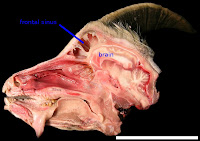Farke, A. A. 2008. Frontal sinuses and head butting in goats: a finite element analysis. Journal of Experimental Biology 211: 3085-3094. doi: 10.1242/jeb.019042
To get a PDF of this paper, try this link first. If it doesn't work, email me at andyfarke [at] hotmail [dot] com, and I'll send you a (legal) link for a free download.
You're a Paleontologist - Why Head Butting in Goats?
This paper is all about the dinosaurs, really! Years ago (when I was in high school, in fact, back in 1996), I read an article by Cathy Forster on skull anatomy in the horned dinosaur Triceratops. She speculated on the function of these sinuses (hollow spaces above the brain and below the horns), noting some similarities with horned mammals such as bighorn sheep. Sheep and many of their relatives
 also have these massive sinuses in their skulls (see image at left) - some researchers posit that the sinuses serve as shock absorbers. The sinuses then protect the brain from being rattled around during horn-to-horn combat. Cathy (and others) thus inferred that because sheep have sinuses, and the sinuses are shock absorbers in these animals, then the sinuses of Triceratops are also probably related to shock absorption. Cool idea, huh?
also have these massive sinuses in their skulls (see image at left) - some researchers posit that the sinuses serve as shock absorbers. The sinuses then protect the brain from being rattled around during horn-to-horn combat. Cathy (and others) thus inferred that because sheep have sinuses, and the sinuses are shock absorbers in these animals, then the sinuses of Triceratops are also probably related to shock absorption. Cool idea, huh?But, I noted one problem: nobody has ever demonstrated that the sinuses of sheep, goats, and their relatives actually act as shock absorbers! It's one of these nice "truths" that remained untried. So, I decided to test this as one small part of my dissertation work on skull function in horned dinosaurs.
Methods to the Madness
How do you investigate head butting in a living animal? One path is to wire up the bone of the skull with strain gages, which measure the deformation of the bone during an activity. This didn't appeal to me for a few reasons: 1) It would be messy and invasive in living animals; 2) it would be just plain messy in dead animals; and 3) there was really no good way to experimentally manipulate the skull anatomy to test the effect of adding or removing sinuses. In all seriousness, it was point 3 that proved the most problematic.
The solution: computer modeling. Specifically, I used a technique called finite element analysis, or FEA for short. In brief, FEA allows you to model the physical "behavior" of a complexly-shaped structure under given conditions. For this study, it was a goat head under a load to the horns. So, what's so good about a computer analysis, over a "real-world" experimental approach? Most importantly, I could really, truly manipulate the skull anatomy. In order to measure the effect of sinuses, I made goat skulls with big sinuses. Goat skulls with small sinuses. Goat skulls with no sinuses at all. You just can't do this in real life!
I chose goats rather than other horned mammals because they were cheap, easily accessible, and a well-studied lab animal already. An archaeologist colleague got me a fresh goat head, which I then CT scanned. From the CT scan, I developed a 3D model of the skull itself. This skull was then imported into commercial FEA software (Algor FEMpro). Finally, I told the software to "pretend" that the goat's horns were being loaded in various directions, to simulate the forces of head butting. I hit the "analyze" button, and waited the half hour or so for the results. . .
Remember, now, that I made models of goat heads with and without sinuses (see the image below left for external views of two of these models, modified from a figure in the original paper; you can't see the sinus region here). If sinuses truly protect the brain, I would expect 1) that strains in the bone surrounding the brain should be greatly
 reduced for models with sinuses; and 2) lots of energy should be absorbed in the walls of the sinuses before reaching the brain.
reduced for models with sinuses; and 2) lots of energy should be absorbed in the walls of the sinuses before reaching the brain.What did I find? Stay tuned for the thrilling sequel to this post!

Hey, Andy. Have you seen this?
ReplyDeletehttp://www.nature.com/nature/journal/v455/n7214/full/455708a.html
Thompson Scientific, makers of EndNote, are suing George Mason University, makers of Zotero, because ... well, basically because GMU are making a competitive product and giving it away and Thompson don't think it's fair that they should have to go to all the trouble of, you know, _competing_, after they were so careful to obtain a monopoly by buying up all their commercial competitors.
This absolutely stinks. I've never bothered downloading Zotero up till now, but I am going to go straight over there right now and get hold of it. I will NEVER buy a Thompson product.